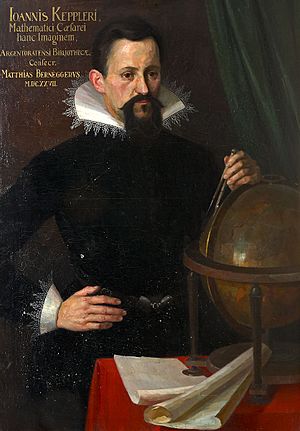Common Era facts for kids
Common Era (CE) and Before the Common Era (BCE) are ways to number years using the Gregorian calendar. This is the calendar most people around the world use today. CE and BCE are other names for the older Anno Domini (AD) and Before Christ (BC) systems.
Both systems mean the same thing: for example, the year 400 BCE is the same as 400 BC. Also, the current year, 2025, can be called 2025 CE or AD 2025.
The idea of "Common Era" goes back to the 1600s. A scientist named Johannes Kepler used a Latin phrase that meant "year of our common era" in 1615. In English, the term "Vulgar Era" appeared in 1635. The word "vulgar" back then just meant "common" or "of the ordinary people," not rude.
Later, in the mid-1800s, Jewish scholars started using "Common Era" more often. Since the late 1900s, BCE and CE have become popular in school and science books. This is because these terms are seen as more neutral and respectful to people of all religions, as they don't refer to Jesus, who is central to Christianity.
Contents
History of Dating Years
How Our Calendar Started
The idea of numbering years from the birth of Jesus came from a Christian monk named Dionysius Exiguus around the year 525. He wanted to stop using an older system that honored a ruler who was unkind to Christians. Dionysius called his new system "Anni Domini Nostri Jesu Christi," which means "Year of our Lord Jesus Christ."
This way of counting years became popular in Europe when a scholar named Bede used it in England in 731. Bede also started the idea of counting years before Jesus's birth, but he didn't use a "year zero." By 1422, Portugal was the last country in Western Europe to switch to this system.
The "Common" Era

The term "Common Era" comes from "Vulgar Era." This term was used to show that dates on the Gregorian calendar were for everyday use, different from the "regnal year" system. Regnal years counted the years a king or queen had been ruling, and they were often used in official government papers. As mentioned, "vulgar" simply meant "of the common people."
The first time the Latin phrase for "common era" appeared was in a 1615 book by Johannes Kepler. In English, "Vulgar Era" was first seen in a book in 1635. The phrase "Common Era" itself appeared in English as early as 1708. By the mid-1800s, it was often used as a synonym for "Vulgar Era" or "Christian Era."
Why Use CE/BCE?
Supporting the Change
Many people support using CE and BCE because it is more inclusive. It shows respect for people who use the same calendar system but are not Christian. The older AD/BC system directly refers to Jesus as "Lord."
Kofi Annan, a former leader of the United Nations, explained it well. He said that the Christian calendar is now used by people of all faiths. It's just a convenient way for everyone to keep track of time together. So, the "Christian Era" has become the "Common Era."
Scholars from different religions, like Jewish, Islamic, Hindu, and Buddhist scholars, have adopted CE and BCE. This allows them to talk about dates using the Gregorian Calendar without going against their own beliefs about Jesus.
Reasons Against the Change
Some people don't like the change to CE/BCE. They point out that the starting point for both systems is still the same. It's still based on the approximate birth year of Jesus. So, even with new names, the calendar's origin is still Christian.
Some Christians feel that removing the reference to Jesus from the dating system is offensive. They prefer to keep the BC/AD abbreviations.
Others argue that if we change the names, some might want to change the numbering system itself, which is also based on Christian origins.
How to Use CE/BCE
When you use BCE, it always comes after the year number. For example, 399 BCE. For CE, it also always comes after the year number. For example, 2025 CE. This is different from AD, which can sometimes come before the year (like AD 2025).
Sometimes, you might see these abbreviations written with periods, like B.C.E. or C.E.
Similar Systems in Other Languages
Many other languages also have their own ways of saying "before our era" or "of our era" that are similar to BCE/CE.
- In Germany, Jewish communities have used terms like "before the common chronology" since the 1700s.
- In Spanish, people use "a. C." (before Christ) but also "a. e. c." (before the common era) in academic writing.
- In Russian, "до н.э." (before our era) and "н.э." (of our era) are used almost everywhere since 1917.
- In Polish, "p.n.e." (before our era) and "n.e." (of our era) are common in history and science.
- In China, the term "公元" (Common Era) is used for both internal and international dating. "公元前" means "Before the Common Era."
- In Czech, "n. l." (of our year count) and "př. n. l." (before our year count) are used, always after the year.
- In Danish, "f.v.t." (before our time reckoning) and "e.v.t." (after our time reckoning) are used like BCE/CE.
Images for kids
-
Johannes Kepler (1571–1630) was a German astronomer and mathematician.
See also
 In Spanish: Era común para niños
In Spanish: Era común para niños
- Astronomical year numbering
- Before Present
- Calendar
- Calendar reform
- Holocene Era
- List of calendars


